Crowfjord
Hazard to Others
  
Posts: 390
Registered: 20-1-2013
Location: Pacific Northwest
Member Is Offline
Mood: Ever so slowly crystallizing...
|
|
Adventures in acetalization
For the past year and a half or so, I have been attempting to form the dimethyl acetal of 3,4,5-trimethoxybenzaldehyde. I initially tried a
CoCl2-catalyzed method with refluxing methanol (1), but a mishap with my water pump compromised the experiment. Without water flow, the
condenser got hot enough allow hot methanol vapor through the CaCl2 guard tube, solvating it and allowing it to drip down in to the
reaction. Despite the problem, TLC showed only about 30% conversion to the acetal.
Subsequent attempts at this reaction had similar results, even with longer reflux times, larger amounts of catalyst, and using methanol freshly
distilled from its reaction with magnesium. I tried using sulfuric acid, phosphorus pentoxide, and dry HCl, all to no avail. I think this particular
benzaldehyde may be acid sensitive, but the problem may have been due to water or other contaminants in the methanol also. Acetals are typically made
from aldehydes with orthoesters, but these are not exactly amateur-accessible compounds.
I got the idea for another approach to acetal formation from an aside Shulgin made in PIHKAL, under the MEM entry. He mentioned that if he tried
to methylate the hydroxyl benzaldehyde with KOH and methyl iodide in too-dry methanol, the acetal was the major product. I had a hard time finding
more examples in the literature. I decided to try this intentionally, by carefully fractionating methanol and dissolving sodium metal in it to ensure
dryness, then reacting this with my benzaldehyde and methyl bromide. The rationale was that the methoxide would react with the aldehyde to form the
deprotonated anionic hemiacetal, which could go on to react with methyl bromide to form the stable dimethyl acetal. Acetals are resistant to
hydrolysis under basic conditions, so any water present would not be able to reverse the reaction. The reaction ended up working, giving a 42% yield
of acetal after purification. Low yield is probably due to side products formed by Tishchenko reaction (a variant of Cannizaro reaction, with
alkoxides instead of hydroxides).
Experimental:
Methanol Fractional Distillation
250 mL HEET methanol was poured into a 500 mL RBF, which was connected to a 30 cm Hempel column packed with sections of broken glass tubing. A
still head, Liebig condenser, take-off adapter and 250 mL collection flask were added. The column and head were insulated first with aluminum foil,
then with dish towels. The vacuum outlet was connected to a CaCl2 guard tube. Low heat was applied from the hot plate, and the first
distillate began to come over about 30 minutes later. Heat was adjusted so that distillate came over at about 1 drop every 3 seconds. The first ~5
mL of distillate were discarded and about 125 mL methanol were collected. The thermometer read 63.5° C throughout (my thermometer reads a little
low). The distillation was stopped early in order to save time and move on to the next step.
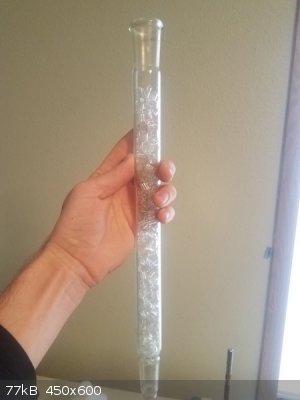 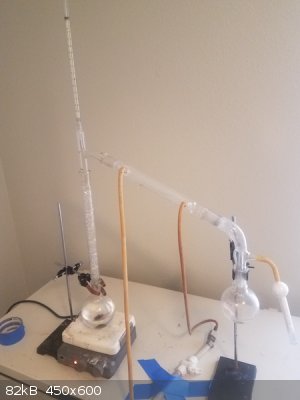 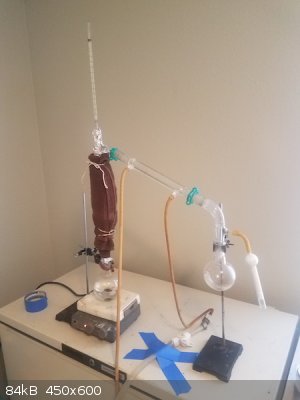
Packed column________________Full setup___________________With insulated column
0.70 g (0.03 mol) freshly cut sodium metal was dissolved in 60 mL of the above freshly distilled methanol, followed by 5.00 g of
3,4,5-trimethoxybenzaldehyde. The mixture was heated briefly to assist dissolution, then filtered while still warm into a ~300 mL swing-top beer
bottle. The bottle was closed and chilled in the freezer to about -12°C.
A methyl bromide generator was set up with 5.8 mL methanol (undistilled HEET) and 8.96 g ~93% H2SO4 (Rooto) in a
pressure-equalized addition funnel connected to the center neck of a 3-neck 500 mL RBF. In the flask was placed a large egg-shaped stir bar, 10.7 g
NaBr.H2O, and 6.9 mL distilled water. One side neck was plugged with a septum and the other connected to a distillation head, thermometer,
Liebig condenser, vacuum take-off adapter, and 100 mL RBF. To the vacuum outlet was connected a PVC tube which ran into a 100 mL volumetric flask
immersed in an ice/salt bath (-15°C). With stirring, the salt/water mixture in the 3-neck flask was heated until condensate filled the flask then
the acid/methanol solution was added at a rate of about one drop per second. Heating and stirring were continued for about 3 hours, with the methyl
bromide condensing in the volumetric flask.
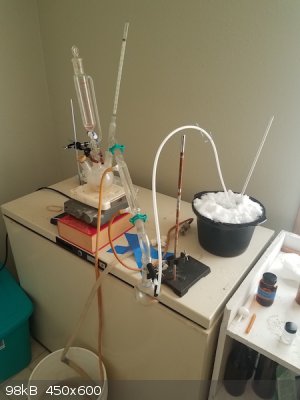 MeBr generator MeBr generator 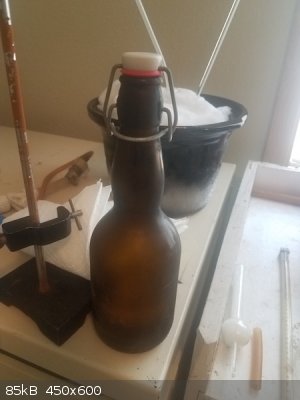 The Ol' Methylatin' Bottle The Ol' Methylatin' Bottle
About 3.75 g methyl bromide were collected and poured into the chilled bottle. The bottle was closed, gently warmed under cool running water, then
heated on a 60°-70°C water bath 1.5 hours. The bath reached 80° once, briefly, before being corrected with cooler water. After cooling to ambient
temperature, silica gel TLC (3:1 naphtha:ethyl acetate, visualized with iodine) showed 3 spots – one immobile at the origin, one yellow spot just
above the origin, and one corresponding to the starting aldehyde.
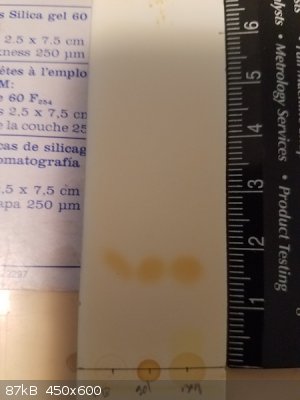
The bottle was re-chilled and methyl bromide generation was repeated as above. 3.66 g methyl bromide were collected and added to the bottle.
Heated on the water bath, 55°-65°C about 1.5 hours. TLC at this point showed the same two spots at and above the origin, a new spot just above the
yellow one, no benzaldehyde, and a new spot higher than that of the benzaldehyde likely corresponding to the dimethyl acetal.
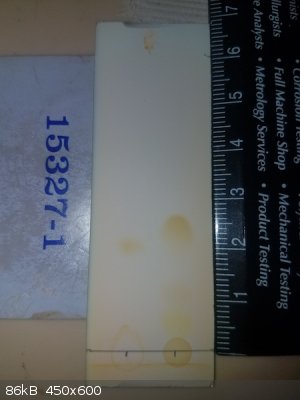 Benzaldehyde left, reaction solution right Benzaldehyde left, reaction solution right
The solution was stored in the closed bottle at ambient temperature for several days before continuing to the next step.
The solution was poured into a 150 mL beaker and 2.07 g sodium bicarbonate was added to neutralize any remaining sodium methoxide or hydroxide.
This was stirred for about and hour, then filtered. The methanol was distilled off (a precipitate forms, probably sodium bromide), the residue
dissolved in a little ethyl acetate (~5 mL) and filtered. An attempt at crude chromatography was attempted, by filtering the solution through a pad
of diatomatious earth (DE) that had been baked for several hours at 260°C, eluting with 70 mL 5:1 naphtha:ethyl acetate. The DE may have adsorbed
some of the yellow compound, but most of it just passed through. The solvent was washed with 20 mL distilled water and dried over CaCl2.
TLC (5:1 naptha:ethyl acetate) showed only the yellow compound and acetal.
The solvent was distilled, and vacuum applied to remove the last traces. The residue weighed 3.10 g.
The residue was vacuum distilled through a short path at ~1-2 mmHg. A clear, colorless liquid came over at 125°-128°C, eventually solidifying
to a colorless solid, melting at 34°-35°C. TLC (3:1 naphtha:ethyl acetate) showed only one spot with Rf=0.38 (3,4,5-trimethoxybenzaldehyde
Rf=0.30). Yield 3,4,5-trimethoxy benzaldehyde dimethyl acetal: 2.55g, 42%.
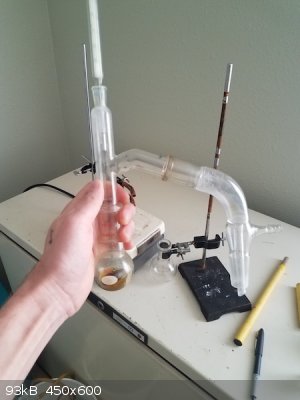 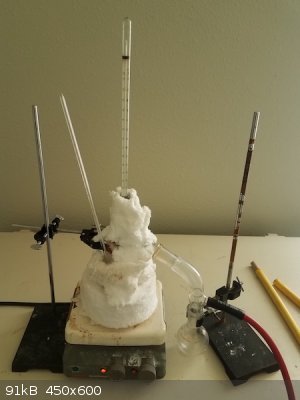 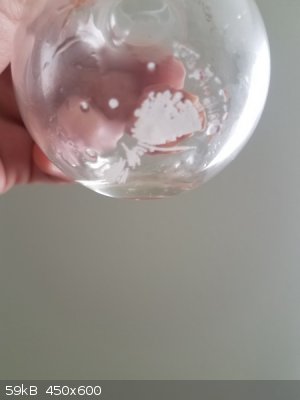 Product mid-solidification Product mid-solidification
Discussion
The above experiment serves as a proof of concept for a little-discussed method of acetalization. Yields may be improved upon by using a larger
excess of methyl halide – the reaction would be able to complete more quickly, avoiding loss of the aldehyde starting material to side reactions.
Losses were probably incurred in the attempt to adsorb the more polar impurities onto diatomatious earth. Silica gel chromatography would be ideal
but alas, I have none. If I were to attempt this method again in the future, I would extract the residue after removing the methanol reaction solvent
with a mixture of a nonpolar solvent and a little ethyl acetate and go from there. Using just nonpolar without any ethyl acetate at all may prove
better/more selective.
Now that I have clean, dry methanol, I am going to try the CoCl2-catalyzed acetalization again. The upside to this method is that
there are no side reactions. The downside is that if the reaction does not go to completion, purification by shortpath vacuum distillation would be
especially difficult (on these small scales), as the benzaldehyde has the lower boiling point.
Reference
(1) Subbarayan Velusamy and T. Punniyamurthy, Tetrahedron Letters 45 (2004) 4917–4920
Attachment: Cobalt (II)-catalyzed chemoselective synthesis of acetals from aldehydes.pdf (234kB)
This file has been downloaded 285 times
Aga, I hope you like all the pictures! I'll try to add more later.
[Edited on 29-12-2017 by Crowfjord]
|
|
|
AvBaeyer
National Hazard
   
Posts: 644
Registered: 25-2-2014
Location: CA
Member Is Offline
Mood: No Mood
|
|
Crowfjord,
This is a very nice piece of work with excellent documentation. Dimethyl acetals are not easily made as you pointed out so your work here as a
follow-on to Shulgin's comments is quite useful.
FYI: Trimethyl and triethylorthoformates are listed on amazon so they can be had.
AvB
|
|
|
Cryolite.
Hazard to Others
  
Posts: 269
Registered: 28-6-2016
Location: CA
Member Is Offline
Mood: No Mood
|
|
In addition, Chemsavers sells trimethyl orthoformate for slightly cheaper (although the shipping on Chemsavers stuff is expensive).
|
|
|
Crowfjord
Hazard to Others
  
Posts: 390
Registered: 20-1-2013
Location: Pacific Northwest
Member Is Offline
Mood: Ever so slowly crystallizing...
|
|
Thanks guys, I appreciate it.
I had forgotten to mention above that I could not find a literature value for the melting point of 3,4,5-trimethoxybenzaldehyde dimethyl acetal, so I
had nothing to compare to the one I determined. My thermometer is not perfectly accurate, also, so the true melting range is probably one or two
degrees higher. That is, the true melting point is probably 35-36°C or 36-37°C.
|
|
|
aga
Forum Drunkard
    
Posts: 7030
Registered: 25-3-2014
Member Is Offline
|
|
Superb experiment, write-up and photos !
Wonderful to see Real work happening, and of such a high standard.
Well done indeed.
|
|
|
aga
Forum Drunkard
    
Posts: 7030
Registered: 25-3-2014
Member Is Offline
|
|
I've made sodium acetate and then distilled that with conc. sulph to make GAA but that's about it.
I get the feeling that you OC guys are having bundles of fun and i'm missing out.
|
|
|
Magpie
lab constructor
    
Posts: 5939
Registered: 1-11-2003
Location: USA
Member Is Offline
Mood: Chemistry: the subtle science.
|
|
This is very nice work, Crowfjord. Thanks for the well done write-up.
In organic chemistry class at my local community college we performed esterifications of vanillin in both basic and acidic conditions. Vanillin is
benzaldehyde with p-hydroxy and m-methoxy groups. The experiment was #64 in Pavia & Kriz' lab manual.
The vanillin was esterified in base to 4-acetoxy-3-methoxybenzaldehyde (vanillyl acetate). This was done with 63% yield, purity "very good" by IR
analysis.
The acid esterification was extremely complex, forming vanillin acetal tri-acetate. Our challenge was to elucidate the mechanism. Yield was 66%,
confirmed as having "excellent" purity by IR analysis.
If anyone wants more details of the mechanism and product structure please ask.
The single most important condition for a successful synthesis is good mixing - Nicodem
|
|
|
Crowfjord
Hazard to Others
  
Posts: 390
Registered: 20-1-2013
Location: Pacific Northwest
Member Is Offline
Mood: Ever so slowly crystallizing...
|
|
Thank you, Magpie. That vanillin acetylation sounds interesting. I don't know if I had heard of acetal esters before, but I can imagine how they
would form. I wouldn't mind hearing more about the procedure and mechanism. Was vanillin esterified with acetic anhydride, with acid and basic
catalysis, or something else?
By the way, I am including here a reference I should have put in the original post that has an example of one of the "typical" methods of making
acetals by way of trimethylorthoformate.
Azzena, U. et al, Synthesis (1990) pp 313-314
Attachment: azzena1990.pdf (198kB)
This file has been downloaded 249 times
|
|
|
Magpie
lab constructor
    
Posts: 5939
Registered: 1-11-2003
Location: USA
Member Is Offline
Mood: Chemistry: the subtle science.
|
|
The experiment is from "Introduction to Organic Laboratory Techniques, a Small Scale Approach," by Pavia, Lampman, and Kriz.
Esterification of Vanillin in the prescence of base:
Dissolve 1.5g vanillin in 25mL of 10% NaOH in a 250-mL E. flask, Add 30g crushed ice and 4 mL of acetic anhydride. Stopper and shake of 20 minutes.
Filter the ppt and wash with 3x 5mL ice cold water. Recrystalize from 50% ethanol, and allow crystals to dry overnight. mp = 77-79°C.
1. vanillin oxy anion is formed upon base add'n
2. this attacks the AA at the carbonyl carbon forming a tetrahedral intermediate.
3. this breaks down to the product + acetate ion.
in acid:
Dissolve 1.5g of vanillin in 10mL of acetic anhydride. Place a mag stir bar in the flask and add 1 drop of 4.5M sulfuric acid. Stopper and stir for
1 hr. Soln will turn purple or purple-orange. Cool flask in ice-water for 3-4 minutes. Add a mix of 20 mL cold water and 15g ice. Stopper and
shake virgorously to induce crystalization. Filter the product and wash with 3x - 5mL ice-cold water. Recrystalize from 95% ethanol. Allow crystals
to dry overnight. mp = 90-91°C.
This mechanism is very long. I can photocopy it for you if desired.
The single most important condition for a successful synthesis is good mixing - Nicodem
|
|
|
Magpie
lab constructor
    
Posts: 5939
Registered: 1-11-2003
Location: USA
Member Is Offline
Mood: Chemistry: the subtle science.
|
|
Here's the mechanisms for the esterifications of vanillin:
in base:
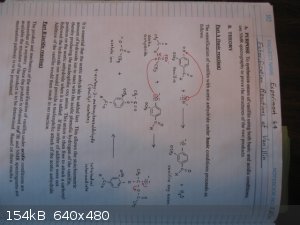
in acid:
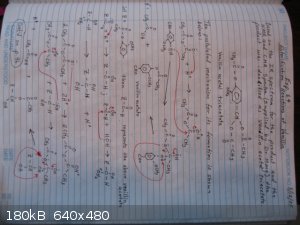
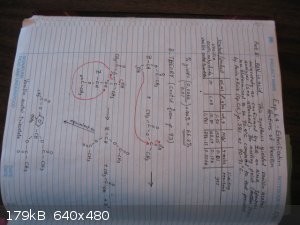
If you toggle on the picture it should rotate 90 degrees.
The single most important condition for a successful synthesis is good mixing - Nicodem
|
|
|
|